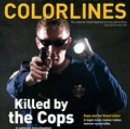
In a joint national investigation, ColorLines and The Chicago Reporter found that Blacks are overrepresented and Latinos a rising number of those fatally shot by U.S. police.
"There is a crisis of perception where African American males and females take their lives in their hands just walking out the door."
This project was conducted with research assistance by Aliza Appelbaum, Beandrea Davis, Erin Dostal, Lynne Nguyen, Marine Olivesi, Julianne Ong Hing, Brittany Petersen, Alena Scarver, Seth Wessler and Shelley Zeiger.
This summer ColorLines and The Chicago Reporter conducted a joint national investigation of fatal police shootings in America's 10 largest cities, each of which had more than 1 million people in 2000. Several striking findings emerged.
To begin, African Americans were overrepresented among police shooting victims in every city the publications investigated.
The contrast was particularly noticeable in New York, San Diego and Las Vegas. In each of these cities, the percentage of black people killed by police was at least double that of their share of the city's total population.
"There is a crisis of perception where African American males and females take their lives in their hands just walking out the door," said Delores Jones-Brown, interim director of the Center on Race, Crime and Justice at John Jay College in New York.
"There is a notion they will be perceived as armed and dangerous. It's clear that it's not just a local problem."
The shootings may be explained in part by implicit bias on the part of police officers, according to research by University of Chicago Assistant Professor Joshua Correll.
A second significant point: Latinos are a rising number of fatal police shooting victims.
Starting in 2001, the number of incidents in which Latinos were killed by police in cities with more than 250,000 people rose four consecutive years, from 19 in 2001 to 26 in 2005. The problem was exceptionally acute in Phoenix, which had the highest number of Latinos killed in the country.
Despite these persistent problems of disproportionate police force in communities of color, a disturbing lack of accountability plagues several of the cities examined.
In Chicago, for example, an examination of media accounts shows that only one shooting out of the 84 fatal police shootings occurred since 2000 has been found unjustified. Monique Bond, spokeswoman at the Chicago Police Department, said that more than one shooting had been determined to have been outside department guidelines, but could not provide specific numbers.
The good news is that police shootings are not inevitable.
After five consecutive years of more than 200 reported incidents of fatal police shootings in cities with more than 250,000 people during the early 1990s, the numbers for these cities fell during most of the decade, dropping as low as 138 in 1999 before resuming a general upward climb to 170 in 2003. These figures may be low due to underreporting by some departments to the federal government.
Washington, D.C., which had the nation's highest rate of police shootings during the 1990s, has cut the rate of shootings dramatically through a combination of training and accountability. Others point to a small but growing number of police departments like Los Angeles and Portland, Ore. that are looking not so much at whether the shootings are justified or not, but about the decisions police and supervisors took that led up to the shootings.
Signs of progress aside, much work remains.
About 9,500 people nationally were killed by police during the years 1980 to 2005 - an average of nearly one fatal shooting per day.
And the failure to address unjustified shootings frankly is likely to lead both to greater community distrust of police and an increased probability that the hostile interactions that often precede the shootings will continue.
"Unless we begin to hold these officers accountable in these cases, they'll only grow in number and significance," Jones-Brown said.
Below is a complete list of the articles in this special web issue of ColorLines.
:: Unequal Protection
Even with the change in administration and a drop in crime, the number of people killed each year by the NYPD remains steady.
:: Why So High?
The Phoenix metropolitan area, with the highest rate of fatal police shootings among the 10 biggest U.S. cities, is also the most dangerous in the nation for Latinos.
:: Missed Signals
The Chicago Reporter found that 45 percent of Chicago police officers named in wrongful death suits have had multiple lawsuits against them but receive minimal internal discipline.
:: Race as a Trigger
Would an unarmed black man be spared a barrage of 41 bullets fired by police officers if he were white?
:: Turning to Tasers
Phoenix police became the first in the country to use Tasers, but will that decrease shootings?
:: Black, Latino Suburbs Have Most Shootings
Using news articles and court records, The Chicago Reporter gathered information on police shootings reported since 2000.
:: Audio: Losing My Brother
Malissia Clinton's brother, James Deon Lennox, was shot to death by Phoenix-area police.
:: Video: Bullets in the Hood
Excerpt from 2004 documentary produced by ProTV and the Downtown Community Television Center.
This article by Jeff Kelly Lowenstein was published first in :: ColorLines, Nov/Dec 2007.



 racism kills
racism kills